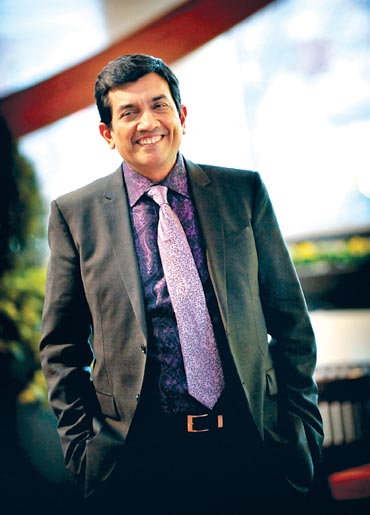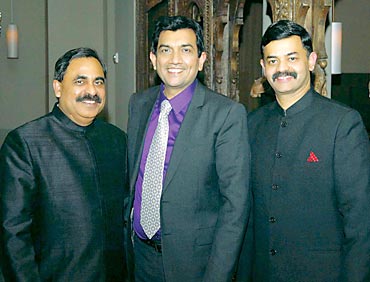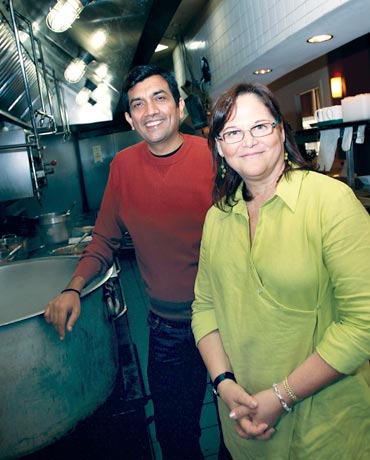
Aziz Haniffa watches celebrity chef Sanjeev Kapoor charm Indian food lovers across cultures and has him discuss how to cook Indian cuisine.
Renowned Indian chef Sanjeev Kapoor, in the United States to launch his first major book geared for the American mainstream audience, How to Cook Indian, took Washington, DC by storm last month.
At a dinner reception hosted by his ex-colleagues K N Vinod and Safraz 'Surfy' Rahman, owners and operators of Indique, more than 200 connoisseurs of Indian cuisine paid $79 apiece or $145 per couple to interact with Kapoor, and sample a dinner that included some of his recipes from the new book.
The Indian food lovers -- mostly non Indians -- stood patiently in line to get their copy of How to Cook Indian, which has more than 500 recipes, autographed.
Washington, DC's leading food critics like Bonnie Benwick of The Washington Post, Steve Dolinsky of ABC's Channel 7; journalists like CNN's Chief White House Correspondent Ed Henry and Washington Post columnist Dana Milbank; and icons in the Washngton, DC restaurant scene like Jose Andres, owner, ThinkFood Group (Jaleo, Zaytinya Caf , Atlantico, and Oyamel), were also present to hear Kapoor, described as 'the Rachael Ray of India' by CNN. In fact, Kapoor has appeared on Ray's popular television show.
Introducing Kapoor as 'the face of Indian cuisine,' Vinod said their association went back to 1984, to the Ashok Hotel in New Delhi. 'It was in this hotel that we worked together that we share a lot of pleasant memories and experiences of catering to prime ministers and presidents of various countries during international conferences,' he said.
Mumbai-based Kapoor, 46, who burst onto the culinary scene in India with a no-fuss cooking approach, is a global sensation. His cooking show is Asia's longest-running television show (Khana Khazana, in its 19th year). His books have sold 10 million copies internationally, and his recipes have come to define Indian cooking in India and worldwide.
"It's time for Americans to finally learn about India's first and biggest celebrity chef, Sanjeev Kapoor," said Food and Wine Magazine. "With a daily television show that has 500 million viewers in 120 countries, as well as more than 140 cookbooks and over 20 restaurants to his name -- plus his own TV station in the making (now launched) -- Kapoor has a huge following of housewives, their mothers-in-law and even their husbands."
In the introduction to How to Cook Indian, Kapoor -- who once cooked for 160,000 people a day along with 100 chefs and claims that no number bothers him after that -- thanks his mother and his wife's family for being major influences.
Kapoor, who was born in Haryana and spent most of his childhood in Delhi, said his father's job took him 'from city to city.'
"My mother has family in Meerut, in Uttar Pradesh, and my paternal aunt lives in Kolkata, and I travelled around India visiting them when I was young," he added. "Wherever my parents set up house, my mother exchanged food and recipes with neighbours from other states and regions, and those dishes made their way onto our table."
His wife Alyona's sister is also a chef and her mother is "a very inspirational cook. These accomplished women have greatly influenced my own way of cooking," he said.
How to Cook Indian covers the depth and diversity of Indian cuisine with recipes for soups and shorbas, kebabs, snacks and starters, vegetarian main course and meat dishes; pickles and chutneys, bread and more. Included are perennial favorites like Butter Chicken, Palak Paneer and Samosa. There is also a chapter on Indo-Chinese fusion and recipes for fasts and festivals.

The book contains a spice guide to help home cooks understand basic flavours. The ingredients he suggests throughout the book are easily available in ethnic stores across the US as well as regular grocery stores. The substitutions he suggests, like cilantro for coriander leaves, make these simple recipes even easier.
Kapoor told India Abroad that Washington, DC-based food writer Monica Bhide, who he met through Vinod, was invaluable in advising him about the nuances that would make it easier for readers in the US to pick out ingredients.
Bhide told India Abroad, "I helped his team create a style-sheet for the US, as things here are called by different names. The cilantro/coriander is one of the main things. But also simple things like the fact that we buy coconut milk canned here and most of his recipes had directions on how to make it. We also worked on making the recipes follow US standards like the fact that ingredients in a recipe should be listed in the order in which they are used. I also helped answer questions on ingredient availability and that of utensils that are hard to find here."
"The world is turning toward vegetarianism, and I can say emphatically that the best guide to vegetarian cooking is Indian cuisine," Kapoor wrote. And with this book, he added, "I try to put to rest the myth that Indian food has to be elaborately prepared...once you have the basic spices on hand, it's just a matter of tossing them into your pan."
Sanjeev was also kind enough to answer a few of our questions about Indian cooking.
How to Cook Indian is targetted toward Indian Americans and mainstream North American audiences?
That's correct. I believe Indians...know me and have read my earlier books, but this North American market -- people who live here, whether Indians or non-Indians, Indians or Americans -- you need to look at this market with a different perspective. A perspective that is all-encompassing; that includes the kind and quality of ingredients that you get here; the pressures that people have here. You need to give them an authentic Indian taste within their own comfort zone. So, this book is perfect for home kitchens in this part of the world. It's a complete compendium of the traditional and classic authentic Indian food. It's unprecedented in terms of how comprehensive it is -- more than 500 recipes.
Will you launch it in other parts of the world?
If we launch it in other parts of the world, we would see if we want to change a few things. It's like, when we launch our books in India, it's not that they are not found here, but they are written from that point of view. This book is written exclusively from the North American perspective. So in this book, for example, you would not find ingredients like coriander leaves, but you would find cilantro.
Can you elaborate?
If you are doing a book for this market, cilantro is an ingredient you can find without any hassle. But if I write coriander leaves, they may go to a market looking for coriander leaves and even the shopkeeper may not know. If they understand ounces and pounds, then you don't want to confuse them with kilos. It's a sign of respect for what they are familiar with and we need to be smart with these things, not possessive or emotional.

What led to this book? Did you do reconnaissance trips to the US?
I have many friends here. Whenever I travelled here, people would tell me that they wanted me to write a book for them. I would tell myself that maybe we should send our existing books from India. But I felt that would not be fair. It had to be something written from their point of view, their perspective, since their pressures are of a different kind, and so are the ingredients. They have different kinds of kitchens, and the way they cook is different. Their needs are different. It took me over four years for this book.
I did quite a few recces to understand the gap, what people want. I spoke to many people. Monica (Bhide, a cookbook author whose third book, Modern Spice, was launched a year ago) was a tremendous help. She arranged locals who tested these recipes. She also made sure the language that we used -- because she's lived in this part of the world for years and has been writing for these audiences for years and understands the nuances -- is American and not the Queen's English that we use back home. I am glad we went through all these pains, because when you look at this book today, I am so proud.
However many reconnaissance trips you make, it's perhaps imperative to have hands-on people tell you how to go about it?
Absolutely. Whether it was people like Monica or Surfy (Safraz Rahman) and (K N) Vinod or Rajesh Bhardwaj in New York, who has just opened Junoon, I would consult with them and try to learn more about how people react to Indian food, specially the mainstream American community. What are their apprehensions; what do they think; what do they say; what do they want? Their contributions were invaluable. There was no way I could have based myself for so long here for all of this research. They were my flag-bearers. Vinod and Surfy have been such invaluable assets.
Over the past decade or so, there has been a proliferation of Indian stores here. So, there's no dearth of ingredients from our part of the world. But yes there are the pressures of time and the lack of help of family and servants. How much of this was factored into this book?
It was a major factor because until and unless a book has utility value, it's no point writing it. I had to constantly ask myself that while a particular recipe was very good, would people make it? How can I encourage more people to cook it? So, I would test that with, for example, the Food and Wine Editor Dana Cowin. She made three of the recipes and she tweeted me and said, 'Fantastic, I made these and it's not only great taste, but I took them to office and my office people loved it, including Indians.' This gave me the confidence that I was on the right track. I am happy that we went through the grind, and I think it's really a proud moment for all of us Indians who can now take pride in a product that is truly Indian, yet can sit in a busy American home and more importantly, serve up a recipe every now and then.

It's a massive book, running into over 600 pages. Isn't there a danger that people may get overwhelmed?
I don't believe so. I thought about it and our publishers thought about it. But the gap in the market was such that there was a dire need for true representation of Indian food. The market was yearning for something comprehensive -- something that was the final word. There is so much information now with the Internet, where with the about the book. So, Indian Americans become a catalyst in the marketing of this book. I've been surprised at the book events we've done, including at Princeton, where we did a book event at the Barnes & Noble. We sold over 85 books, which my publisher said was one of the most successful book events they'd had in the past few years. I believe that is the power of Indian food.
Are you considering opening a restaurant in the US?
Definitely. I am convinced there is space for upscale Indian restaurants like Indique and Rasika and I would like to show Americans that Indian food is something that can be compared to and hold its own and then some to any other food from any part of the world -- Italian, French or whatever. I believe there's a need; there's a demand and I would love to do it sooner than later.